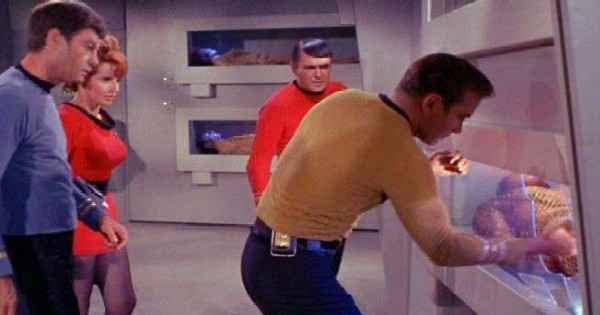|
Cryonics There's a certain irrefutable logic to cryonics which goes something like this: What have you got to lose?
There's a certain irrefutable logic to cryonics which goes something like this: What have you got to lose? What indeed? If you've got the cash to spare, then why not have your corpse frozen until some time in the unspecified future, when people will be able to cure whatever caused your death. While a "slim" chance maybe be better than "no" chance, the odds that you will successfully be reanimated at some point in the future are pretty forbidding, even relative to things like winning the lottery or making an unsatisfactory lover change for the better. Since the time of ancient Egypt, mankind has been trying to preserve corpses in the hope of future reanimation. In case you hadn't noticed, this effort has been 100% unsuccessful to date. Cryonics per se (also known as cryogenics), the art of freezing a body to prevent decomposition, is a younger science but it's still been around long enough to demonstrate why it's a bad bet. Part of the problem with cryonics is that, much like time travel, there's really no big reason why it shouldn't work, it's just that we have no idea how it actually could work. Microbes, fish and a few other low-order cold-blooded life forms can in fact be frozen alive and thawed back to life. Depending on the specific critter, you can re-animate months, years or millennia later.
The notion of cryonics as a formal "scientific" discipline in which people are put on ice for future reanimation more or less originated with a 1964 book called "The Prospect of Immortality," by a college professor named Robert Ettinger. Ettinger's book began with a quite inspiring, if utterly misguided, introduction to the notion. Emphasis in the passage below is that of the author, who was enamored of italics long before desktop publishing put them within the reach of the ordinary citizen:
Most of us now living have a chance for personal, physical immortality.It's hard to even know where to begin trashing this proposition. But let's start with the science. The sales pitch for most cryonics facilities will tell you that there's a virtually endless amount of scientific support for the effectiveness of cryonics, in fact, so much support that "a quick summary is impossible," as one "institute" puts it.
The process of freezing causes its own damage, as Ettinger concedes. He assumes that future peoples will be able to fix this damage. Unfortunately, this is extremely unlikely. Did you ever stick a can of soda in the freezer only to discover later that it blew up? That's because water expands when it's frozen. The cells of the human body are filled with water. Perhaps you can see where this is going. While it's possible to cushion certain kinds of cells (like sperm and embryos) from this effect under certain conditions, these techniques are so far completely ineffective on the macro scale of a human body (or any mammal, for that matter). So when you cryonically freeze someone (assuming you do the whole body and not just the head), you physically explode every single cell in the body, just like that soda can. Since there are more than 10 trillion cells in the average adult human body, that's an awful lot of exploding. Assuming you found some microsurgical technique to even repair the exploded cells in the first place, you would then have to repeat the process more than 10 trillion times to fix the freezing damage. Furthermore, many of these calls are inconveniently located in what the scientists refer to as the "inside" of the human body, which would additionally require our intrepid reanimator to take the body apart to the cellular level, repair it, then reassemble the 10 trillion cells in the correct order. If you try to explain this to a cryonics proponent, they will smugly respond "nanotechnology," a word derived from the Greek root nanos, which means "dwarf" (as used in the sentence "My dwarfish intellect has been dwarfed by a gigantic wave of wishful thinking"). If someone tells you they are relying on nanotechnology to solve their problems, Rotten.com suggests you sell them some Florida swampland or a nice bridge in Brooklyn.
The second big scientific problem is that, unlike the frozen fish and eels that cryonics supporters love to cite, the people being frozen in cryonics labs are DEAD (except for a few mad scientists out somewhere we don't know about). The fish and eels that pop back to happy life after freezing were both alive and healthy when they froze. The people are DEAD. Let's repeat that, again, in capital letters: DEAD. DEAD. DEAD. And nearly all of those people, before being dead, were very, very old or very, very sick. There's a mighty big difference between thawing out a live healthy eel and a dead decrepit geezer. Many cryonics labs also offer a discount service in which only the head is frozen (a full-body freeze costs $120,000 or more). Medical science is not currently able to graft a head onto a body with a viable result, nor is medical science able to keep heads alive using an artificial body or by any other means. So, let's sum up the scientific aspect here. According to Ettinger, "our future friends" will have to accomplish the following before any cryonics subjects will be thawed and reanimated:
Let's just forget Ettinger's ludicrous notion that Social Security will pay for all this someday. Senior citizens can't even get the prescription drugs they need to stay alive. It's hard to imagine a point at which the federal budget is willing to appropriate trillions of dollars to freeze every American citizen who dies. But skip that. Look at this from the point of view of human society. Even if you're Albert Einstein (and you're not), there is ABSOLULTELY NO REASON why society would EVER get around to bringing your frozen corpse back to life. PERIOD. Einstein was a brilliant guy, but science has already passed him by. In another 50 or 100 years, his groundbreaking work will be kindergarten science. And old Uncle Albert hasn't even been frozen, now has he? Legend states Walt Disney was frozen, but that's actually a lie. The only notable person to be frozen in the history of cryonics so far is baseball legend Ted Williams, whose severed head was apparently tossed around the cryonics lab like a dodge ball. And it's not at all clear that Williams even wanted to be frozen in the first place. Let's walk through the logic here. What possible reasons could society have for reanimating corpses?
There is only one person in all of history weird enough and beloved enough to have pulled this one off. His name was Elvis and it's too late for him. If Elvis had chosen to have his corpse frozen, SOMEONE would eventually have found a way to reanimate him. Someone, somewhere, somehow. But Elvis didn't, and everyone else is fucked. Better luck next afterlife.
Timeline
|
 Having observed this process, scientists began to speculate that you could freeze people who had died from some currently incurable disease or the currently incurable malady known as "old age," and thaw them out some time in the future, after science has figured out the way to cure their ailments.
Having observed this process, scientists began to speculate that you could freeze people who had died from some currently incurable disease or the currently incurable malady known as "old age," and thaw them out some time in the future, after science has figured out the way to cure their ailments.  Interestingly, a quick summary of the evidence AGAINST cryonics turns out to be rather simple. Yes, it's possible to preserve corpses without deterioration... if the deterioration you're talking about is visible stinky rot.
Interestingly, a quick summary of the evidence AGAINST cryonics turns out to be rather simple. Yes, it's possible to preserve corpses without deterioration... if the deterioration you're talking about is visible stinky rot.  Future technology could certainly make cryonics more viable, if they can figure out a way around the exploding cell thing. But the cell thing needs to be fixed before the freezing, and not afterward.
Future technology could certainly make cryonics more viable, if they can figure out a way around the exploding cell thing. But the cell thing needs to be fixed before the freezing, and not afterward.  The much bigger issue is: Who the fuck wants to see your icy ass reanimated?
The much bigger issue is: Who the fuck wants to see your icy ass reanimated? 
